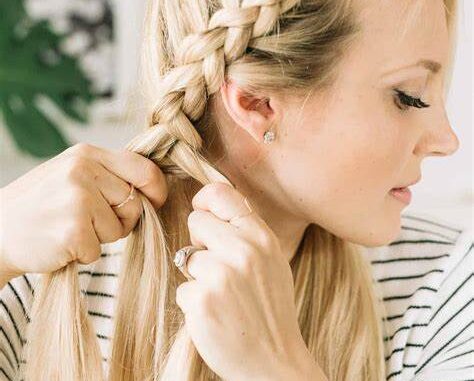

braid
音标:
英音/ breɪd / 美音/ breɪd /
听听基本释意:
外刊例句:
They wear their names and numbers on their backs, their hair tied in long, neat braids.
他们的背上刻着自己的名字和号码,头发扎成又长又整齐的辫子。
—New York Times
Gilpin describes the show as “No Country for Old Looney Toons,” and revels in the braided genres she gets to act in.
吉尔平将这部剧描述为“老鲁尼卡通无国界”,并陶醉于她所扮演的辫子类型。
—Washington Post
I choose to wear my hair in braids to protect it from getting damaged and dirty when I play.
我选择把头发编成辫子,以防止玩耍时头发受损和弄脏。
—BBC
基本释意:
verb
make by braiding or interlacing
(装饰家具和军装的)彩色穗带;<美>发辫,辫子
同义词:
lace,plait,pleach,plait,tress,twist,braiding,gold braid
短释义:
Have you ever seen someone with their hair bound together in thick, rope-like arrangements? That hairdo is called braids. Women often braid each other’s hair or get it braided by a hairdresser. The longer your hair, the longer your potential braids. To braid hair, you have to weave the strands of hair together: this is also called plaiting, lacing, and interlacing. Other materials can be braided, but the most popular thing to braid is definitely hair.
编织就是用花边或编织在一起。这样做出来的头发就是辫子。
长释义:
Have you ever seen someone with their hair bound together in thick, rope-like arrangements? That hairdo is called braids. Women often braid each other’s hair or get it braided by a hairdresser. The longer your hair, the longer your potential braids. To braid hair, you have to weave the strands of hair together: this is also called plaiting, lacing, and interlacing. Other materials can be braided, but the most popular thing to braid is definitely hair.
你见过有人把头发绑成粗粗的绳子状吗?这种发型就叫辫子。妇女们经常互相编辫子或让理发师编辫子。你的头发越长,你的辫子就越长。要编辫子,你必须将几缕头发编织在一起:这也称为编辫子、系带和交错。其他材料也可以编辫子,但最流行编辫子的绝对是头发。
文学例句:
Turtle had dashed in shouting: “The braided tortoise strikes again!” and kicked a surprised Theo in the shin.
乌龟冲了过来,大喊道:“辫子龟又来袭了!”踢了惊讶的西奥的胫骨。
—The Westing Game by Ellen Raskin
He wore a blue suit buttoned all the way up the front with bright gilt buttons, and trimmed with braid, and he had copper-toed shoes.
他穿着一套蓝色西装,前面的扣子一直扣到前面,上面镶着明亮的镀金纽扣,并饰有辫子,脚上穿着铜趾鞋。
—Little House in the Big Woods by Laura Ingalls Wilder
Then she had braided her hair, using her hands to interweave the thick dark strands deftly, tying the end of the heavy plait with a leather strip.
然后她把头发编成了辫子,用手巧妙地把粗黑的发丝交织在一起,用皮条把粗辫子的末端绑起来。
—Gathering Blue by Lois Lowry
词源:
braid (v.)”plait, knit, weave, twist together,” c. 1200, breidan, from Old English bregdan “move quickly, pull, shake, swing, throw (in wrestling), draw (a sword); bend, weave, knit, join together; change color, vary; scheme, feign, pretend” (class III strong verb, past tense brægd, past participle brogden), from Proto-Germanic *bregdanan “make sudden jerky movements from side to side” (compare Old Norse bregða “brandish, turn about, move quickly; braid;” Old Saxon bregdan “weave, braid;” Old Frisian brida “twitch (the eye);” Dutch breien “knit;” Old High German brettan “draw, weave, braid”), perhaps from a PIE root *bhrek- (compare Sanskrit bhurati “moves quickly,” Lithuanian bruzdùs “fast”), but there are phonetic difficulties. In English the verb survives only in the narrow definition of “plait hair.” Related: Braided; braiding.Related entries & more
下面是词源的翻译(机器翻译比较难翻,参考着看)
辫子(v.)“编结、针织、编织、捻在一起”c。 1200, breidan, 源自古英语 bregdan “快速移动、拉、摇、摆动、投掷(摔跤)、拔(剑);弯曲、编织、编织、连接在一起;改变颜色、变化;计划、佯装、假装” (第三类强动词,过去式 brægd,过去分词 brogden),源自原始日耳曼语 *bregdanan“从一侧到另一侧突然做出急促的动作”(比较古挪威语 bregða“挥舞,转身,快速移动;辫子;”古撒克逊语bregdan “编织、编织;”古弗里斯兰语 brida “抽搐(眼睛);”荷兰语 breien “针织;”古高地德语 brettan “绘制、编织、编织”),可能来自 PIE 词根 *bhrek-(比较梵文 bhurati “动作很快”,立陶宛语 bruzdùs“快”),但存在语音困难。在英语中,这个动词只存在于“辫子头发”的狭义定义中。相关:编织;编织。相关条目及更多
本站没有存储任何书籍、杂志和报纸。
页面内容只做展示和推荐。如果您喜欢本期内容请购买正版。
This site does not store any books, magazines or newspapers.
The contents of the pages are for display and recommendation only.
If you like the content of this issue please purchase the original.